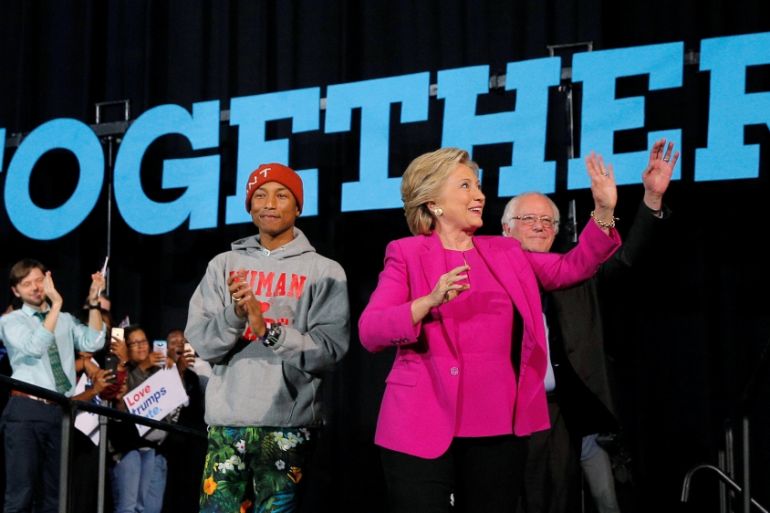Why Donald Trump draws crowds, Hillary Clinton doesn’t
Some analysts believe many are simply reluctant to admit they’re on Hillary Clinton’s side.

It makes fans of Hillary Clinton very anxious every time I state this simple fact: attendance at the Democratic candidate’s rallies is mediocre at best.
The pictures have told the story over the past six months. Republican Donald Trump is filling convention centres, airport hangars and parks. Clinton, on the other hand, is filling community centres and small colleges, but just barely.
Keep reading
list of 4 itemsTogo’s parliamentary election: Why all eyes are on President Gnassingbe
Has South Africa’s ANC failed to live up to its promises?
April 27, 1994: What has changed in South Africa 30 years after apartheid?
The people campaigning for her – the rock stars of the Democratic Party such as First Lady Michelle Obama, President Barack Obama and Vermont Senator Bernie Sanders – have bigger and more energetic crowds.
Moreover, as Clinton goes into the final weekend of campaigning, she is drawing on mega-celebrities to attract people to her cause by holding separate events with musicians Pharrell Williams, Jay Z and Katy Perry.
There was a momentary spike this past week in Tempe, Arizona, where, aside from July’s Democratic National Convention, she had one of her biggest rallies yet.
More than 10,000 people attended an event where she went solo. But you could chalk that up to the fact that a Democratic presidential nominee in Arizona is rare. Unlike Florida, North Carolina, Pennsylvania, Wisconsin, New Hampshire and other battleground states, Arizonans aren’t bombarded with campaign stops.
![Clinton's rallly in Winterville, North Carolina, on Thursday [Chris Sheridan/Al Jazeera]](/wp-content/uploads/2016/11/8fe950156e3c41a8a29e6599b58b5efa_18.jpeg)
Conservative media and Trump himself have pointed to the smaller size of the rallies and bring it up all the time.
“I have to say, we have rallies like this and we have seven, eight, nine, ten thousand routinely,” he boasted back in September at a stop in North Carolina. “Hillary goes out for rallies and yesterday I think she had 200 people, maybe 300.”
But some analysts believe that, contrary to Trump’s persistent assertion that there’s a “silent majority” in the United States who want him to win, the opposite may be true and that could explain at least some of the low numbers at Clinton rallies.
Proud Trump supporters
There is no doubt Trump supporters are proud to say they’re voting for him. That’s been evident since the beginning of his campaign.
But Lara Brown, an associate professor of political management at George Washington University, argues size doesn’t necessarily matter.
“Trump is a novelty and for some, to say that they went is like saying they went to a sporting event,” she argues. “Trump has also regularly been going to places where he is most beloved, not where the ground game is most competitive.”
Other analysts believe many are simply reluctant to admit they’re on Clinton’s side.
The controversies surrounding her – the use of a private email server while secretary of state, allegations that she gave special access to world leaders while in government in exchange for donations to her family’s foundation and, more recently, an FBI investigation into her staff emails – have made it harder for people to show their love.
TIMELINE: Who got the right to vote when?
“I’ve had a number of students tell me that they’re reluctant to be too public or too publicly enthusiastic over their support for Clinton,” says Chris Galdieri, assistant professor at St Anselm College in New Hampshire. But he believes the support is there.
“My wife recently took our daughter to see Clinton at an event here in New Hampshire,” he says. “And met women from New Hampshire and other states who had brought their daughters with them specifically to see Clinton, because there’s a good likelihood she will be the first woman president.”
The Clinton campaign insists they’ve baked the small numbers into their strategy. At a stop in Winterville, North Carolina, I asked one of Clinton’s top aides whether she is concerned about the mediocre attendance.
“We’ve gone into less populous parts of the state for a reason,” said Jennifer Palmieri, Clinton’s communications director. “There are voters in this area [North Carolina] that we want to turn out, so if you go to a place where there aren’t as many people who live there, you aren’t likely to get the crowds.”
On a Friday conference call with reporters, Robby Mook, Clinton’s campaign manager, said they’ve had success in early voting getting people who haven’t cast a ballot much in the past – so-called “low propensity voters” – to come out to the polls.
But on the same call campaign officials barely addressed questions about reports that African-American early voting is down from 2012. That’s a key group of people for Clinton.
At the end of the day, the voting booth is where the attendance really counts.
“Enthusiasm is great, but it doesn’t predict the result,” says Brown.
|
|